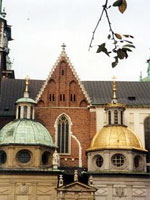 Krakow OverviewThe only major city to escape the destruction of World War II,
Krakow has one of the best-preserved medieval city centres in all
of Europe. The Old Town is a significant UNESCO World Heritage Site
and retains a wealth of architectural gems from different periods,
with magnificent churches and aristocratic palaces lining the old
streets, reminiscent of its glorious days when it was the abode of
kings and royalty. At the heart of the city lies one of the
grandest squares in Europe, the Old Market Square. The charming Old Town is a compact area encircled by leafy
parkland that forms a green belt around the historic centre. The
main entrance to the old city was through the Florian Gate, set
within the original city walls, now the haunt of artists and full
of galleries containing their work. With a thriving cultural life,
it has been home to many of the nation's greatest writers, artists
and intellectuals, and is one of the main cultural centres in the
country, a spirited city with personality and charisma. Overlooking the city is Wawel Hill, topped by the striking Royal
Castle and Cathedral, the seat of Polish kings for seven centuries
and the symbols of Polish national history. Also important is the
city's Jewish roots, and the history of one of the great Jewish
centres in Europe can clearly be seen in the old ghetto area of
Kazimierz, and starkly remembered in the memorial death camps of
Auschwitz and Birkenau, west of Krakow. Situated on the banks of the Vistula River, Krakow is also a
modern city, the third largest in Poland, and an important
university centre boasting the oldest university in Europe. The
large student population creates a lively atmosphere and a vibrant
nightlife. Countless cafes and outdoor restaurants surround the
cobbled main square. The unique atmosphere of this medieval city
has made it one of Poland's most popular tourist destinations. |